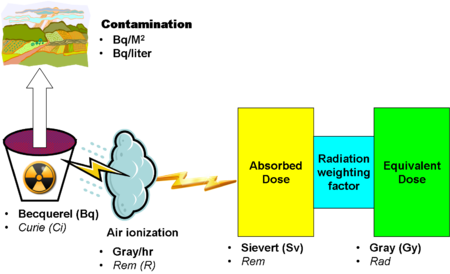Units of radioactivity
For the quantitative measurement of different aspects of radioactivity, there are a substantial number of units of radioactivity. The number is relatively high because the aspects include the energy of a radiation source, as well as the effect of ionizing radiation in air, absorbed in arbitrary materials, and specific effects on biological systems. Doubling the number of units is the reality that they are defined both for the International System of Units (SI) and in "traditional" or "customary" units.
Properly interpreting the units can be quite complex. A given quantum of ionizing radiation will have different effects not only due to the type of radiation, which is considered in the computation of the units of biological effect, sieverts and rems, but also due to the energy level within a radiation type. Fast, medium-speed and slow neutrons, for example, have different biological effects.
Activity of a source of radiation
As opposed to most of the other units, the SI unit becquerel[1] (Si) and the common unit curie (Ci) deal with the activity of the source, not the effects on radioactivity reaching its destination. Linked with area or volume measurements, these units are useful in giving a quantitative measurement of contamination of areas of the ground or volumes of water. When the source contains multiple isotopes, as with a reactor accident, it is most useful to state activity of each isotope.
Basic units
1 Bq = 1 event of radiation emission per second. Since this is a very small unit, common measurements are:
- 1 kBq = 103 Bq
- 1 MBq = 106 Bq
- 1 GBq = 109 Bq
The older unit, the Curie (Ci), is equal to 37 GBq. The Curie is a large unit, so common representations are
- 1 mCi = 10-3Ci
- 1 uCi = 10-6Ci
- 1 nCi = 10-9Ci
- 1 pCi = 10-12Ci
Linking the two sets of units,
Measuring contamination
Contamination of surfaces, such as the ground near a radiation release, is stated in Bq or Ci units per square metre. Contamination of water is expressed in Bg or Ci per liter.
Refining activity
Neither the Bq nor the Ci measure the energy of release from the source, only its rate. The energy is specified in electronvolts.
Ionization of air
Roentgens measure the ionization of air from a radioactive source, but knowing that is less important than knowing other measurements.
Absorption in materials
Biologic effects
| Radiation type | Energy level | Biological effect |
|---|---|---|
| Gamma rays and x rays | All | 1 |
| Beta particles | All | 1 |
| Neutrons | < 10 KeV | 5 |
| > 10 keV to 100 keV | 10 | |
| > 100 keV to 2 MeV | 20 | |
| > 2 MeV to 20 MeV | 10 | |
| > 20 MeV | 5 | |
| Alpha particles | All | 20 |
Qualifiers
Decay reactions
References
- ↑ While the abbreviations of units are capitalized, the spelled-out names are not, to avoid confusion with the person they honor.
- ↑ Radiation - Quantities and Units of Ionizing Radiation, Canadian Centre for Occupational Health and Safety
| Property measured | SI unit | Other unit | Notes |
|---|---|---|---|
| Rate of emission from a source |
|
|
|
| Air ionization by radiation |
|
|
|
| Absorbed dose |
|
|
|
| Biological equivalent dose |
|
|
